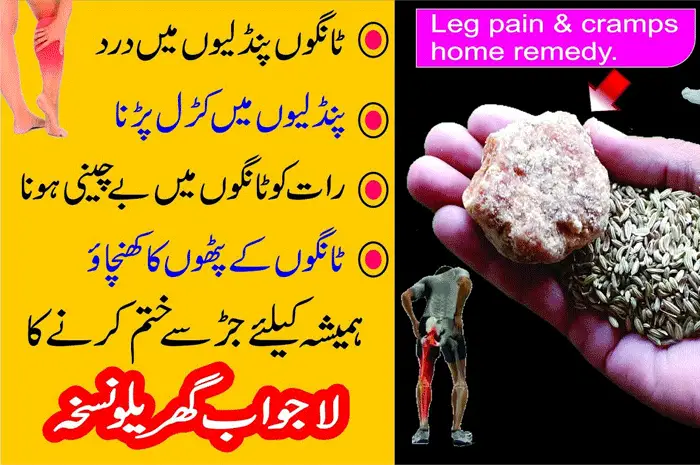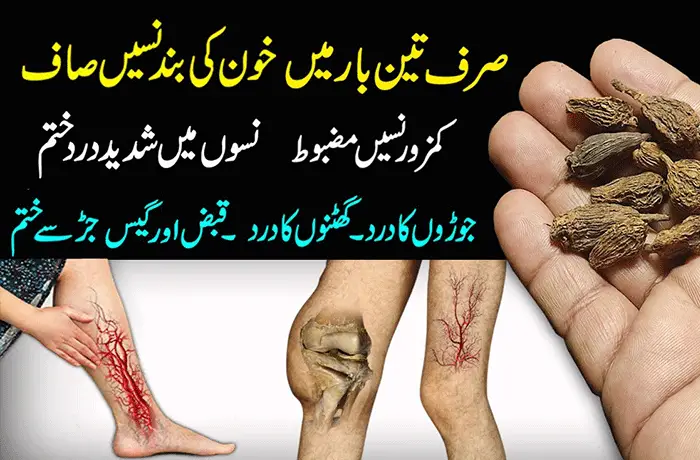
Having leg pain or cramps can be uncomfortable and can stop us from doing things we like. It might be a sudden pain or a lingering ache, but knowing why it happens and how to make it better can make a big difference in how we feel every day. In this article, I will share some simple and effective ways you can use at home to make your leg pain and cramps feel better.
These tips and remedies have been tried and tested, and they work fast. They can help you get back to doing things you love without discomfort. I have included a helpful video at the beginning. It’s a good idea to watch it first because it will give you a good starting point for what we will be talking about.
Ease Leg Pain and Cramps with Home Remedy (Urdu)





Causes of Leg Pain and Cramps:
Leg pain and cramps can have various causes, so identifying the root issue is crucial for proper treatment. Some common culprits include:
Muscle Fatigue and Overexertion:
When we use our leg muscles a lot or do really tough activities, we can get tired and worn out. This can happen when we push ourselves too much or do things that make our leg muscles work hard. When this happens, we might feel sudden and painful muscle cramps. It’s like our muscles telling us they need a break and some attention. These cramps can happen while we’re doing the activity or after we’ve finished. Understanding why this happens helps us figure out how to stop it from happening again and how to make it feel better when it does.
Dehydration and Electrolyte Imbalance:
When we don’t drink enough water or if our body lacks important minerals like potassium, calcium, and magnesium, our muscles can start to act up. This might lead to muscle spasms and cramps, which are those sudden, tight muscle contractions that can be painful. So, it’s important to make sure we’re getting the right amount of fluids and nutrients to keep our muscles working smoothly and pain-free.
Poor Blood Circulation:
Conditions that affect how blood flows in our body, like peripheral artery disease or deep vein thrombosis, can cause leg discomfort. Peripheral artery disease makes it harder for blood to get to our legs, which can lead to pain and cramps. Deep vein thrombosis happens when a blood clot forms in a deep vein, usually in the legs, causing pain and swelling. These conditions mess up how well our blood moves around, and that’s what causes the discomfort in our legs.
Nerve Compression or Irritation:
When a nerve is pinched, it means something is pressing on it too hard. This can happen because of conditions like sciatica or herniated discs. Sciatica is when the big nerve that goes from your lower back to your legs gets squished or irritated. This can make your leg feel tingly, numb, or painful. A herniated disc is when the soft cushions between your spine bones poke out and press on a nerve. This can cause sharp pain that shoots down your leg. These conditions can make it hard to walk or sit comfortably for long.
Tips to Reduce Leg Pain and Cramps:
It’s really important to do things that stop leg pain and cramps from happening. When you build good habits, you can lower the chances of feeling uncomfortable. Here are some easy tips to help you do just that:
Stay Hydrated:
Ensure you’re drinking an adequate amount of water daily. This helps maintain proper electrolyte balance, reducing the risk of cramps.
Stretching Exercises:
Regular stretching, especially for the calf and thigh muscles, can enhance flexibility and reduce the occurrence of cramps.
Maintain a Balanced Diet:
Eat foods rich in essential minerals like potassium, calcium, and magnesium. Include bananas, leafy greens, and dairy products in your diet.
Gradually Increase Exercise Intensity:
Avoid sudden, intense workouts. Instead, gradually build up your exercise routine to give your muscles time to adapt.
Remedies for Leg Pain and Cramps
Despite our best efforts, occasional leg pain and cramps may still occur. In such instances, it’s essential to know how to alleviate the discomfort effectively. Here are some tried-and-tested remedies:
Gentle Massage:
Massaging the affected area with gentle, circular motions can help relax tense muscles and provide relief.
Apply Heat or Cold Packs:
Applying a warm compress or cold pack to the affected area can help soothe muscle discomfort and reduce inflammation.
Pain Relief Medicines:
Non-prescription pain relievers like ibuprofen or acetaminophen can offer temporary relief from mild to moderate leg pain.
Raise Your Legs:
If you can, lift your legs. This helps blood move better and reduces any swelling. Just find a comfortable place to sit or lie down, then prop up your legs. It’s like giving your legs a little break. This is especially good after sitting or standing for a long time. So, whenever you can, put your feet up and let your blood flow back to your heart easily. This can help if your legs feel sore or swollen.
In conclusion, leg pain and cramps are common discomforts that can significantly impact our daily lives. By understanding the causes and implementing preventive measures, we can minimize their occurrence. Additionally, having effective remedies at hand ensures that we can quickly alleviate any discomfort that arises.






